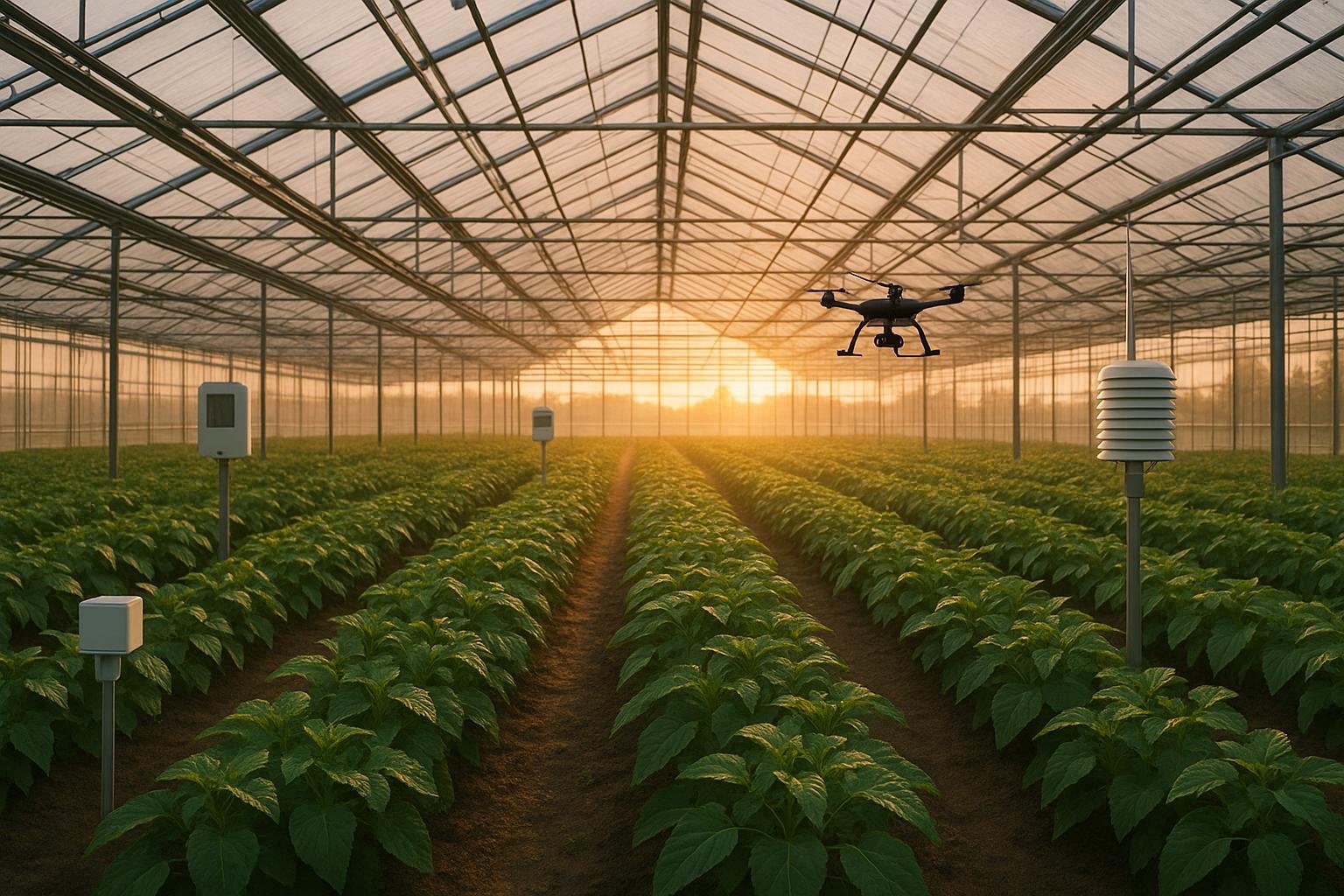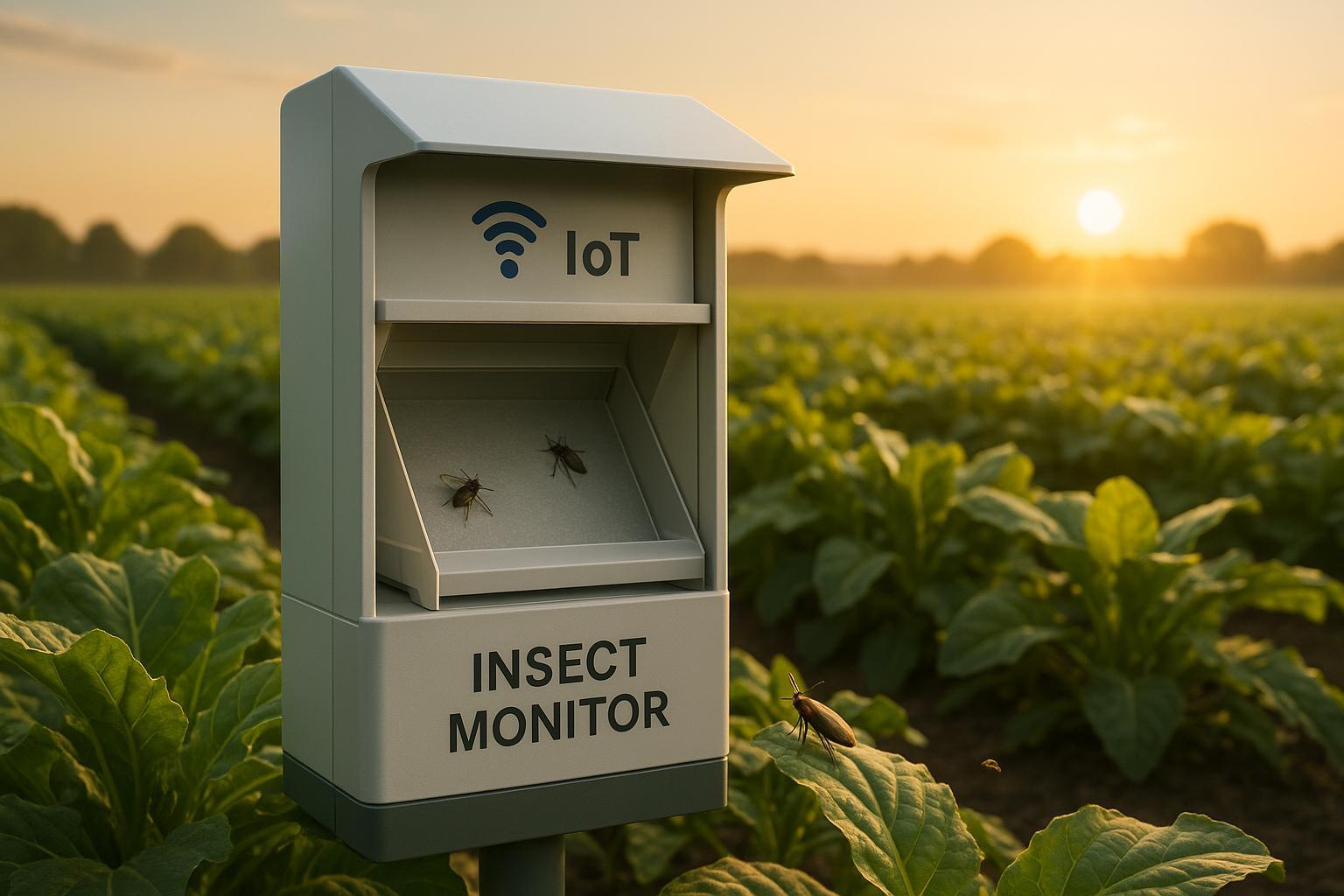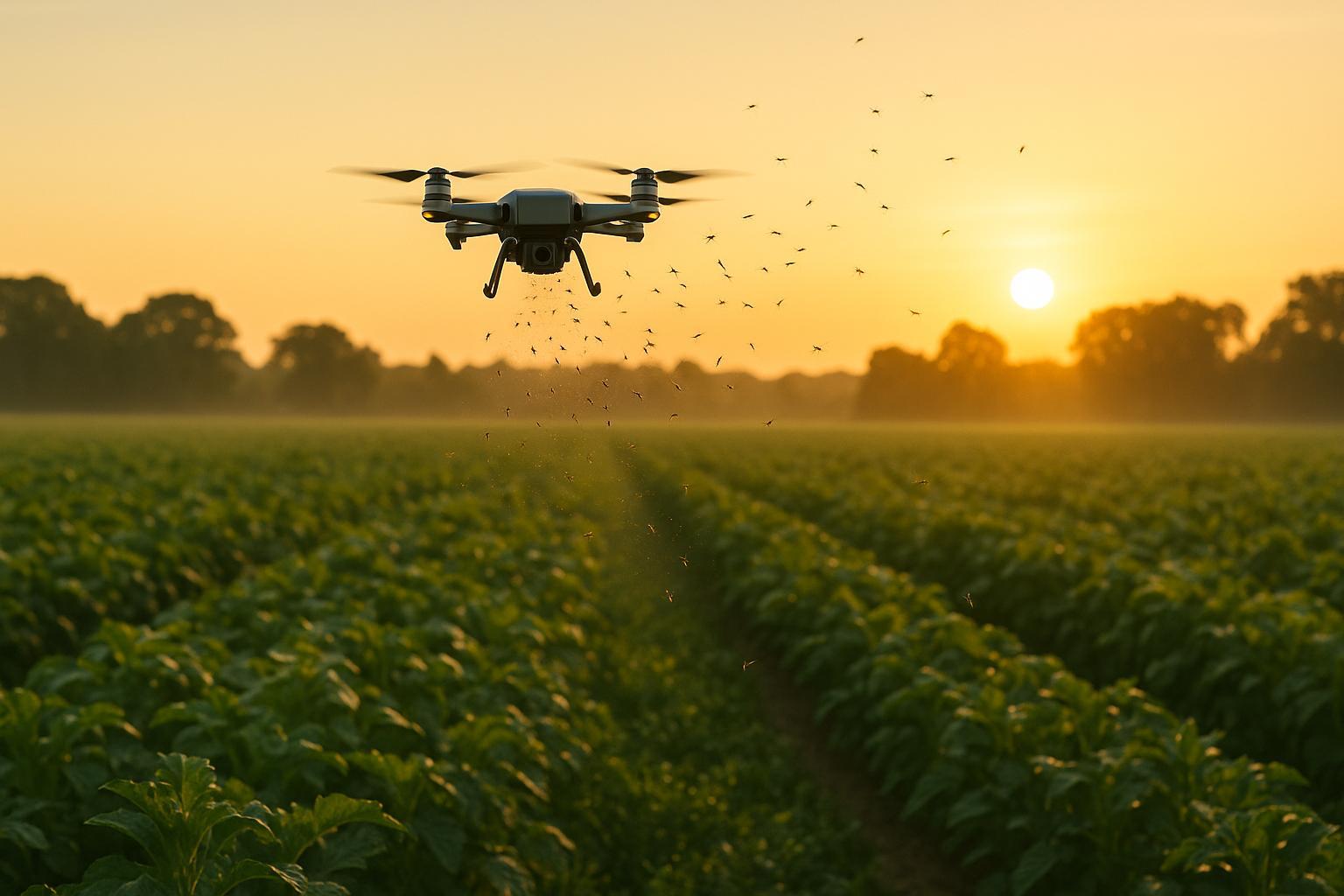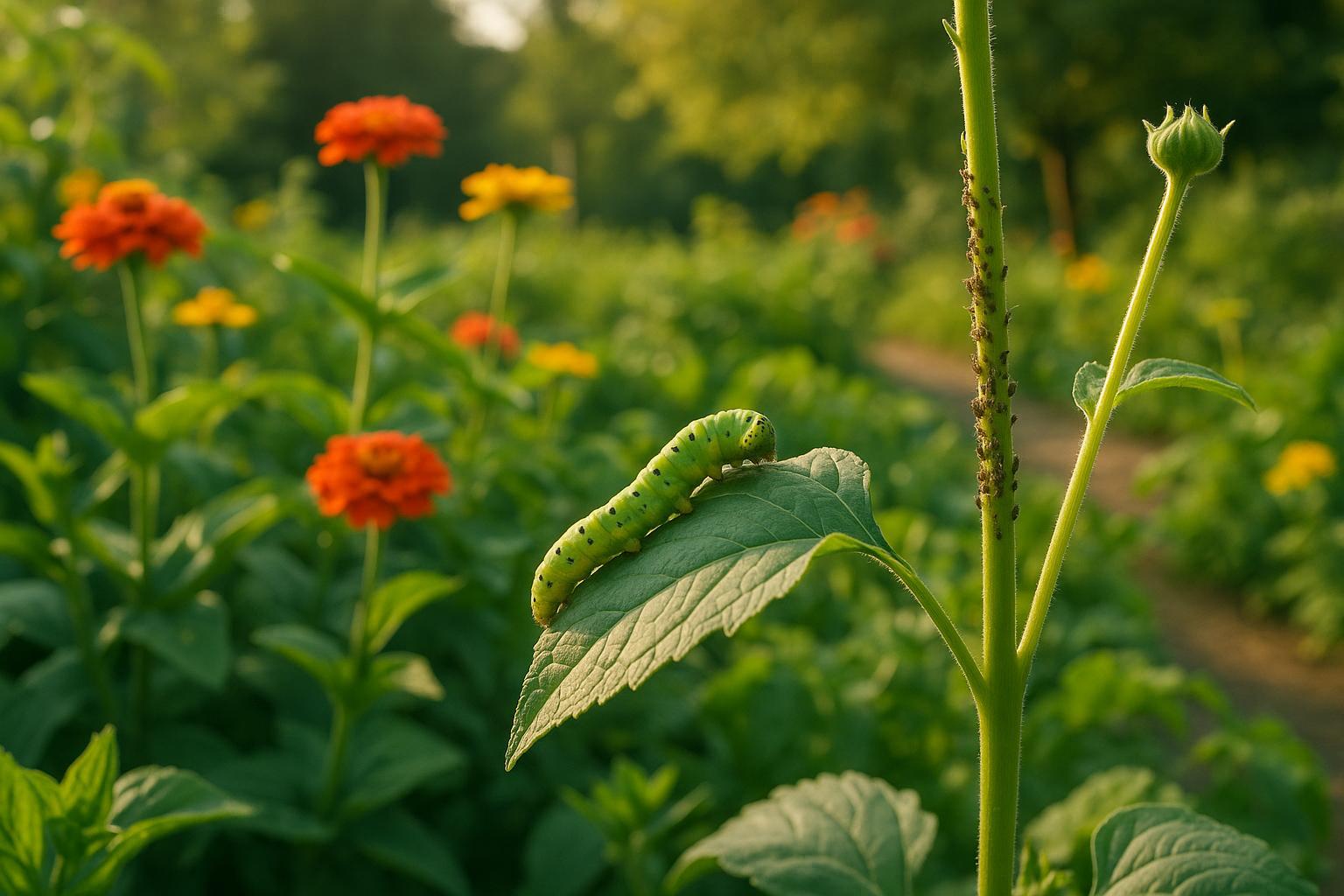IoT in Biocontrol: Case Studies

IoT is transforming pest management by combining smart sensors, automated systems, and natural pest control methods. This approach reduces chemical use, improves precision, and simplifies pest control for both large-scale farms and home gardens. Key features include:
- Sensors and Smart Traps: Monitor pests and environmental conditions in real-time.
- Automated Systems: Release biological agents like beneficial insects or pheromones at optimal times.
- Predictive Analytics: Use data to anticipate pest outbreaks and recommend actions.
- User-Friendly Software: Accessible dashboards for monitoring and decision-making.
Case Studies:
- California Orchards: Automated traps and drones reduced pest damage in apple and pear orchards.
- Florida Greenhouses: Environmental sensors helped prevent disease outbreaks in high-value crops.
While upfront costs are higher, IoT systems save money over time by lowering pesticide use, improving crop health, and providing actionable data. Challenges include technical expertise and maintenance, but the long-term benefits make IoT-enabled biocontrol a promising choice for modern agriculture and gardening.
PestTrap | Digital Pest Tracking Station | Monitor Pests Remotely


Key Components of IoT-Enabled Biocontrol Systems
IoT-enabled biocontrol systems bring together smart hardware and advanced software to manage pests in a natural, efficient way. By combining physical devices with intelligent technology, these systems create a seamless approach to biological pest control.
Hardware: Smart Traps, Sensors, and Automation Devices
The hardware in IoT biocontrol systems includes a network of devices designed to monitor, detect, and respond to pest activity in real-time.
- Smart traps are a leap forward from traditional pest monitoring tools. Equipped with sensors and attractants, these traps automatically identify and count pest populations. They can even differentiate between harmful pests and beneficial insects using image recognition, ensuring accurate data collection. Alerts are sent when pest levels exceed thresholds, allowing for timely intervention.
- Environmental sensors track key factors like temperature, humidity, soil moisture, and light, helping determine the best conditions for biological control measures.
- Weather monitoring stations provide detailed, localized data on meteorological conditions. Sensors for wind speed, direction, and rainfall help predict pest movement and identify the right times for applying biological treatments.
- Automated release mechanisms take precision to the next level. These devices deploy beneficial insects, pheromone lures, or other biocontrol agents exactly when needed. Using drones or ground-based dispensers, they act based on real-time data and algorithmic decisions.
- Communication hardware ties all components together through wireless networks. Technologies like LoRaWAN, cellular modems, or satellite links ensure reliable data transmission, even in remote areas.
Together, these hardware components create a robust network that feeds accurate, real-time data to the system’s software, setting the stage for smarter pest management.
Software: Management Platforms and AI Integration
Building on the data collected by hardware, the software transforms raw information into actionable insights and automated responses.
- Data collection and processing platforms act as the brain of the system. They gather data from various sensors, validate it, and filter out errors or noise to ensure decisions are based on reliable information.
- Predictive analytics engines use machine learning to anticipate pest outbreaks. By analyzing historical and current data, these engines improve their accuracy over time and adapt to specific local conditions.
- Decision support systems evaluate factors like pest pressure, weather, crop growth stages, and the availability of biocontrol agents. Based on this analysis, they recommend the best times to release beneficial insects, apply treatments, or take other actions.
- Automated control algorithms take decision-making a step further by enabling the system to act without human input. When certain conditions are detected, these algorithms can trigger responses such as releasing biocontrol agents, activating pheromone dispensers, or sending alerts. Built-in safety protocols ensure treatments are used responsibly and protect the surrounding environment.
- Mobile applications and web interfaces make the system accessible to users. Farm managers can monitor pest activity, review treatment histories, and adjust settings from their phones or computers. Features like dashboards, maps, and reports provide a clear view of system performance.
- Integration capabilities allow these systems to work alongside other farm management tools. Through APIs, they can share data with crop management platforms, weather services, and agricultural databases, creating a more unified approach to farm operations.
Case Studies of IoT-Enabled Biocontrol
When it comes to pest management, IoT-enabled biocontrol systems are proving to be game-changers. These technologies not only improve how pests are managed but also help reduce the environmental impact of traditional methods. Let’s dive into a couple of real-world examples to see how this works.
Smart Traps and Automated Insect Release
In California's Central Valley, apple and pear orchards are using IoT-based solutions to tackle codling moth infestations. These growers have turned to smart pheromone traps equipped with image recognition and wireless communication. The traps automatically identify and count pests, sending real-time data to the system. If pest counts cross a certain threshold, drones or ground-based dispensers are triggered to release biocontrol agents precisely where needed. Over several growing seasons, this approach has significantly reduced pest damage while cutting back on the use of chemical pesticides. The result? Healthier crops and a more sustainable pest management process.
Environmental Monitoring for Disease Prevention
In Florida, greenhouse operators are leveraging IoT systems to protect high-value crops like tomatoes and cucumbers from diseases. Multispectral sensors detect early signs of issues like fungal or bacterial infections - often before they become visible. These systems also monitor key environmental factors such as temperature, humidity, air circulation, and soil moisture to prevent conditions that could lead to disease outbreaks. Additionally, beneficial microorganisms in the root zone are tracked, and if their levels drop, the system prompts targeted interventions. Advanced sticky traps further distinguish between harmful pests and helpful insects, automatically initiating biocontrol measures when necessary. This integrated approach has led to fewer disease outbreaks, better water and energy efficiency, and higher crop yields.
These examples highlight a shift in pest control strategies - from reactive methods to predictive, precision-based solutions. By combining real-time monitoring with automated and targeted actions, IoT-enabled biocontrol systems are creating more sustainable growing environments that benefit both farmers and the natural ecosystem.
🚀 Ready to Reinvent Your Garden?
Join thousands of homeowners who have transformed their gardens using our AI design tool. Upload one photo to explore endless possibilities.
Get your AI garden designs →Benefits and Challenges of IoT-Enabled Biocontrol
IoT-enabled biocontrol offers precise pest management and improved efficiency but comes with financial and technical hurdles.
By targeting pests more accurately, this approach reduces waste and protects beneficial organisms. Automated systems provide continuous monitoring, catching potential issues early. This not only lowers treatment costs but also helps prevent significant damage to crops.
However, adopting IoT technology isn’t cheap. Advanced sensors, communication tools, and software platforms come with steep upfront costs, far surpassing those of traditional methods. On top of that, the complexity of these systems often requires growers to either develop specialized skills or rely on technical support for installation and maintenance.
Here’s a side-by-side look at how IoT-enabled biocontrol stacks up against conventional pest control methods:
| Aspect | IoT-Enabled Biocontrol | Conventional Methods |
|---|---|---|
| Precision | Targets specific areas using real-time data | Broad application across entire fields |
| Labor Requirements | Automated, continuous monitoring reduces manual work | Relies on periodic manual scouting |
| Initial Investment | High upfront costs | Lower initial costs for basic tools |
| Ongoing Costs | Software subscriptions and maintenance | Recurring expenses for pesticides and labor |
| Response Time | Quick, automated responses | Dependent on scheduled inspections |
| Data Collection | Comprehensive, historical data | Limited record-keeping |
| Technical Expertise | Requires specialized knowledge and support | Familiar, straightforward techniques |
| Environmental Impact | Reduces chemical use, preserving beneficial organisms | Can lead to chemical residues and resistance |
| Scalability | Expandable with additional sensors and modules | Expansion requires more manual labor |
While IoT systems provide valuable data for better decision-making, they’re not without their flaws. Network outages, sensor failures, and software glitches can disrupt monitoring, presenting reliability concerns.
Other challenges include a steep learning curve for users and the need to navigate changing regulations around automated biological releases. Still, many growers see the long-term advantages - like reduced costs and a smaller environmental footprint - as worth the initial investment. Plus, IoT systems often integrate with broader farm management tools, creating opportunities for streamlined operations.
Balancing these trade-offs is key, especially as IoT-enabled biocontrol begins to intersect with AI-driven garden planning, shaping the future of pest management.
sbb-itb-4d6a8dd
Integration with AI-Powered Garden Planning Tools
Bringing together IoT-enabled biocontrol systems and AI-powered garden planning tools creates a smarter approach to pest management. By combining real-time environmental data from sensors with tailored plant selection and layout strategies, this tech-driven integration simplifies everything from garden design to targeted pest interventions.
AI tools process a variety of data - soil health, climate trends, pest histories, and plant compatibility. When linked to IoT biocontrol systems, these platforms can predict pest outbreaks and schedule the release of biological control agents at just the right time. For example, IoT sensors continuously monitor conditions like temperature, humidity, and pest activity. This data is sent to cloud-based AI, which calculates the best moments to deploy biocontrol measures.
One standout example is AIGardenPlanner, which merges AI-driven garden design with sensor-based recommendations to improve biocontrol planning. Its AI Plant Advisor suggests plant combinations that attract beneficial insects while keeping pests at bay. The system even recommends strategic garden layouts to maximize IoT-monitored pest control efforts. For instance, it might propose placing trap crops in areas where sensors detect high pest activity or creating habitats for helpful insects near vulnerable plants.
Benefits for Home Gardeners and Landscapers
The combination of IoT and AI offers distinct advantages, whether you're a home gardener or a professional landscaper.
For home gardeners, these tools provide professional-level pest management without requiring advanced expertise. AI platforms turn complex sensor data into straightforward, actionable advice. Imagine getting a notification that suggests releasing ladybugs or alerts you to rising aphid activity in a specific garden zone. While the upfront cost of sensors and software subscriptions may seem steep, many gardeners find they save money over time compared to traditional pest control methods.
Professional landscapers, on the other hand, benefit from scalable solutions that allow them to monitor multiple properties at once. A single dashboard can display pest data across various locations, making it easier to plan service routes and schedule interventions. Over time, the AI learns the unique conditions of each property, refining its recommendations and reducing the need for last-minute pest control measures.
This tech-driven approach also strengthens client relationships. Instead of reacting to pest damage after it happens, landscapers can share predictive analytics and proactive plans with their clients, building trust and transparency.
Another key advantage is precision. AI analysis of IoT data pinpoints specific zones that need attention, avoiding the blanket application of biological controls across an entire property. This targeted approach not only cuts costs but also improves the overall effectiveness of pest management.
Seasonal planning becomes more efficient, too. By analyzing historical data, AI platforms can identify recurring pest issues and guide landscapers in making preemptive decisions, like choosing pest-resistant plants or preparing biocontrol agents in advance. This ensures resources are ready when they’re needed most.
Finally, these systems are designed to be user-friendly, even for those who aren’t tech-savvy. Sensor data is translated into clear, visual garden maps that highlight pest hotspots, beneficial insect activity, and suggested intervention points. Whether you're a seasoned landscaper or a weekend gardener, these tools make advanced pest management accessible and practical.
Conclusion
IoT-enabled biocontrol is reshaping the way gardens and agricultural spaces are managed. The examples we've explored highlight how these systems are already delivering tangible results.
Take automated insect traps, for instance - they don't just cut down on labor costs but also make pest control more efficient. Similarly, environmental monitoring systems help detect potential disease outbreaks early, shifting pest management from a reactive approach to a proactive, data-driven process. These case studies underline the power of this technology to transform how we manage pests and environmental challenges.
What's even more exciting is how accessible these tools have become. Home gardeners now have access to advanced monitoring systems once reserved for large-scale commercial operations. AI-powered tools can interpret sensor data and provide clear, actionable recommendations, making it easier for everyone to make informed decisions. Professional landscapers, on the other hand, can scale these systems across multiple properties, using predictive analytics and transparent reporting to strengthen their client relationships.
The combination of IoT sensors and AI-driven planning tools creates an interconnected system where every decision is guided by real-time data. This approach not only improves efficiency but also reduces environmental impact by ensuring resources are used precisely where they're needed.
As sensor prices continue to drop and AI technology evolves, IoT-enabled biocontrol is on track to become the norm rather than the exception. Its ability to analyze historical trends, adapt to specific conditions, and refine predictions makes it a game-changer for sustainable pest management.
For those ready to take the plunge, the path is straightforward: start small with basic monitoring tools, incorporate AI-driven planning as you go, and expand your system as you gain confidence. The future of pest control is here, blending biological methods with smart technology to create a more effective and sustainable way forward.
FAQs
How do IoT-powered biocontrol systems compare to traditional pest control methods in terms of cost and efficiency?
IoT-powered biocontrol systems offer a smarter and more efficient alternative to traditional pest control methods. These systems allow for early pest detection, minimize the need for manual inspections, and enable precise, data-driven interventions. The result? Lower overall costs and improved effectiveness in managing pests.
Research highlights that IoT systems significantly improve the accuracy of pest monitoring and speed up response times. This leads to more efficient pest management and less waste of resources. Over time, these advancements not only streamline pest control efforts but also reduce the dependence on chemical treatments, providing a more sustainable and cost-effective solution for pest management.
What skills are needed to set up and manage an IoT-based biological pest control system, and how can I learn them?
To successfully set up and manage an IoT-enabled biological pest control system, you’ll need expertise in several areas: IoT device setup, networking protocols, data analysis, cybersecurity, and cloud computing. These skills are essential for ensuring smooth communication between devices, safeguarding data, and keeping the system running efficiently.
You can build these skills through various learning paths, such as online courses, certification programs, or specialized IoT training. Focus on resources that cover key topics like device configuration, communication protocols, and system security to establish a solid knowledge base.
Can IoT-based pest control systems be adapted for home gardens, and what advantages do they offer to gardeners?
🎨 Visualize Your Dream Garden Today!
Transform any outdoor space into a professional landscape design in minutes. Just upload a photo, choose your style, and let our AI do the rest.
Start your garden transformation now →Can IoT-Based Pest Control Work for Home Gardens?
Absolutely! IoT-based pest control systems are a game-changer for home gardeners. These systems rely on sensors to track key factors like soil moisture, temperature, and pest activity, helping gardeners manage pests more effectively and efficiently. With this technology, you can conserve water, grow healthier plants, and cut back on chemical pesticides - all while keeping your garden thriving.
What’s more, IoT systems make gardening easier and more accessible. They offer remote monitoring and real-time updates, so you can keep tabs on your garden even when you’re not at home. Designed for small-scale use, these eco-friendly solutions not only save time and effort but also encourage sustainable gardening practices. Whether you're a seasoned green thumb or just starting out, IoT technology can simplify your gardening journey.
Related posts
Related Articles

The Benefits of Raised Outdoor Planters for Your Garden: A Comprehensive Guide
Discover the advantages of using raised outdoor planters for gardening, including better drainage, soil quality, and easier access. Learn about the different types of raised outdoor planters and how to choose the right one for your needs. Get step-by-step instructions for building your own DIY raised outdoor planter.

How IoT Calibration Improves Pest Monitoring Accuracy
Learn how IoT calibration enhances pest monitoring accuracy, reduces pesticide use, and ultimately leads to more effective pest management.

AI Timing for Parasitoid Releases
AI enhances the timing of parasitoid releases for pest control, improving effectiveness and reducing costs through data-driven insights.

Effective Strategies for Asiatic Garden Beetle Control
Discover key factors and methods for controlling and preventing Asiatic garden beetle infestations. Learn about identification, preventive measures, and various control options.

How Climate Affects Pest Risks in Gardens
Climate change is altering pest behaviors, leading to increased risks in gardens. Learn how to adapt and manage these challenges effectively.

Are European Garden Spiders Poisonous? A Comprehensive Guide
Learn about the appearance, behavior, and venom of European garden spiders. Find out if they are poisonous to humans and what to do if bitten. Discover how to prevent garden spider bites and why they are beneficial to have around.